| 1 | Horned adder |
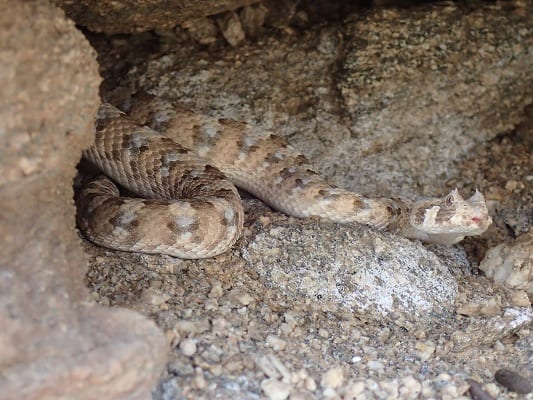
The horned adder (Bitis caudalis) has two things going for it in the invisibility stakes: excellent camouflage and a diminutive size. This is a southern African species, part of the same Bitis family as puff adders and gaboon adders. Horned adders stick to parched areas like dry savannahs, rocky canyons and even sand dunes of the Namibian desert.
This is where their masterstroke arrives. Horned adders are not only variable in colour, but adjust based on soil types. In deserts they’re beige, while in the red canyons of western South Africa, they too are reddish. Horned adders are so variable that some look like a different species. Size completes the package, with a wild record of just 52.3cm, and an average of 20-35cm. Horned adders are nocturnal, staying still during the day. They live in open areas, but have a tendency to lurk by rocks for shade.
All this adds up to a snake that is easy to miss on your grand tour of South Africa. A cape cobra can be seen prowling from far away. Black mambas can slither with their chest raised 1 metre vertically. The horned adder doesn’t make it easy for anyone.
| 2 | Ruby-eyed pitviper |
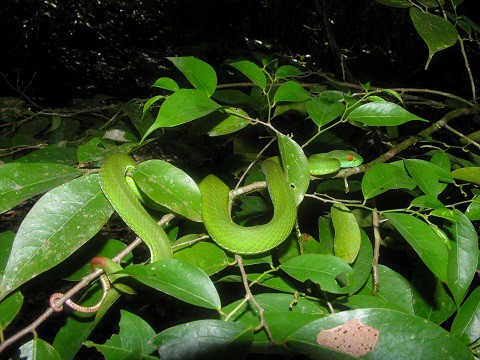
A snake that Vietnam war soldiers almost certainly met in the 1970s. Or more accurately, they may have walked right past it and not noticed a thing, focussed on waves of enemy guerrillas as they were. The ruby-eyed pitviper (Trimeresurus rubeus) is the main green pitviper of Vietnam, and is especially common in the south. Its venom is largely cytotoxic, and capable of swelling your entire arm up if its fangs strike flesh. They live in pristine forests, resting on branches all day, occasionally extending their upper body into mid-air and flecking their tongue for scents.
Being almost fully green, ruby-eyed green pitvipers effortlessly blend with foliage. They’re ambush predators, and are fine-tuned to stay invisible. The first you hear of their presence may be a piercing hiss. However, Trimeresurus rubeus does give explorers a chance; its ruby red eyes contrast vividly with its leafy green body. Like a videogame boss, it’s a finely horned killing machine with just 1 weakness you need to target.
Search for a pair of red eyes floating around, as it may be your only chance in the forests of Vietnam. In Thailand, white-lipped pitvipers are the main family member, and this version has typical yellow eyes.
| 3 | Lataste’s viper |
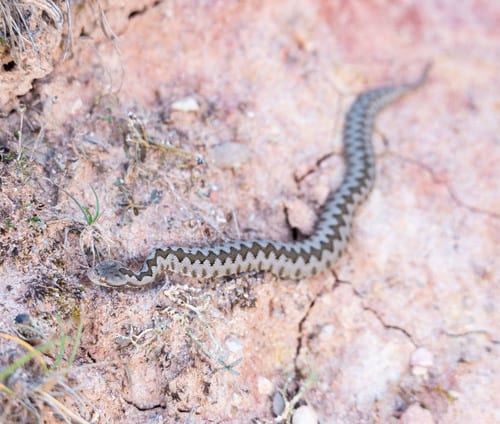
Lataste’s viper is a small Spanish species measuring 30-60cm, with a record of 73cm. It covers the entire lower 75% of Spain, plus Portugal, with Baskian vipers controlling the north.
Lataste’s vipers are growing steadily more endangered, due to their narrow habitat requirements. They mainly inhabit rocky slopes, within forests and on their outskirts. On the plus side, this allows Lataste’s viper to easily disappear, as this species is stone grey itself. They have odd zigzagging patterns and facial markings, which are simply an even darker shade of grey. They’re also not particularly large, and stay calm when approached, rather than hissing and acting unhinged.
The result: Lataste’s viper is a very tricky species to spot. The best bet is to identify rocky hillsides, perhaps from a knowledgeable 70 year old villager who knows the countryside like the back of his hand. Lataste’s vipers have a moderately dangerous venom, though barely any confirmed deaths are known. Symptoms include waves of nausea and vomiting, blistering and swelling plus blackening fresh extending from the bite wound.
| 4 | Green-black lancehead |
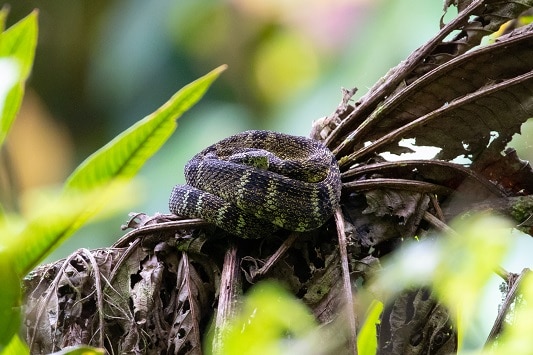
Another of the 40+ Bothrops pitviper family, but part of a small subgroup also containing the green jararaca (Bothrops bilineatus). Green-black lanceheads are an obscure snake, and live exclusively on eastern slopes of the Andes, in pristine forests of Peru and Bolivia. They have a narrow range compared to common lanceheads, preferring a small forest kingdom which they totally rule over.
Green-black lanceheads are difficult to spot because of their branch dwelling ways, and shifting colours which are optimised for blending in. Some are green-black, others have blue patches, and others look like a galaxy viewed through a high powered telescope. The goal is to blend with the rainforest in all its exotic glory. Like a coral reef, rainforests are so swarming with life that it’s difficult to spot the Bothrops chloromelas lurking in the corner.
This is a patient snake rather than a reckless charger. They’re an ambush snake, which lets the rainforest shift and swirl around them before seizing their chance. Bothrops chloromelas is rarely sighted even by scientists. Any reptile enthusiast would struggle after the long, hard trek in. His long-planned expedition might be wasted in a fruitless search. If he did find one, he’d instantly gain respect among his peers.
| 5 | Northwestern neotropical rattlesnake |
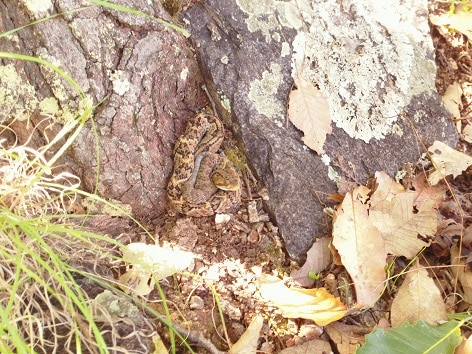
Away from the familiar timbre rattlesnake, which you can observe in peace from a picnic bench in South Carolina, there’s a whole case of less researched rattlesnakes in harsher parts of the Americas. One of is the northwestern neotropical rattlesnake (Crotalus culminatus). This lives only along the southern Mexican coast, hugging the Pacific ocean.
Crotalus culminatus lives in rolling hilly areas, with plenty of rocks and dry forests. Their venom contains 6-11% crotamine, a myotoxin which paralyses the hind legs of mice and rats. They’re also a very difficult species to spot. Their colours are the classic subtle viper shades: beige, black and brown. Unlike a coral snake, Crotalus culminatus doesn’t wish to advertise itself to the world. It wishes to blend in, disappear, only sounding its bone-chilling rattle when backed into a corner.
Crotalus culminatus is particularly invisible in dry forests and bushy vegetation, whereas on an open plain, they’re slightly easier. This Mexican rattlesnake would be a very easy species to walk past, and never realise that you’d met.
| 6 | Sind krait |
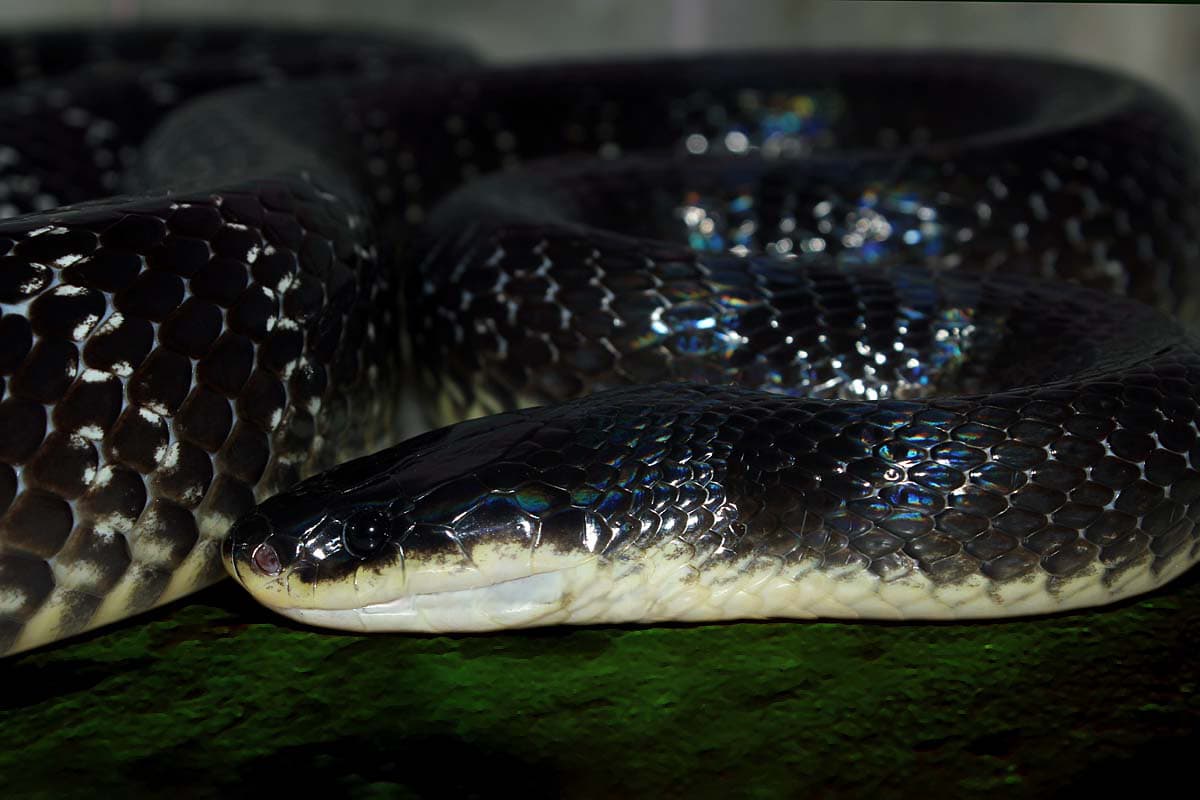
A venomous snake of western India and eastern Pakistan. Sind kraits measure 100cm, max 180cm, and are cousins of India’s common krait (Bungarus caeruleus), a terror which belongs to India’s “big 4” for annual snakebite fatalities. While less common, sind kraits are just as neurotoxic, causing respiratory paralysis and a 6 day session of artificial ventilation in one victim.
Adding to the danger is that they’re very tricky to spot, even for people with certified 20/20 vision. Sind kraits are nocturnal, hiding by day, and prowling for food at night. They’re notorious for entering tents and huts while people sleep. Two bite victims were at a construction site in Maharashtra state, west India. Yet spotting them outside is a nightmare.
Compared to the kraits of Thailand, Sind kraits lack the sharply defined black-white bands. They’re much plainer, being a dusky black with occasional white lines. Like a horror movie villain, you could easily wave your torch over this snake in quick succession, and not realise they’re right there. The torch dweller might not be convinced, his instincts telling him that something’s out there, before reluctantly retreating to his tent.
| 7 | Mangshan pitviper |
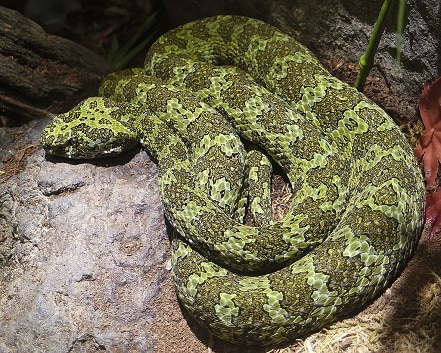
This Chinese pitviper is unique in that it disguises itself against mossy boulders. It’s green, yet not neon and juicy like a ruby-eyed pitviper. Mangshan pitvipers have far more complex shades of green, allowing them to blend with jumbled rocks and buttresses on the forest floor.
This species only lives in moist mountainous forests, rather than dry woodlands. Mangshan pitvipers (Protobothrops mangshanensis) live in oppressive jungles of hammering rainfall and constantly chirping insects, exclusively in southwest China. No-one would enter those jungles except on a research project, and if you did, you probably wouldn’t spot the Mangshan pitviper. Like March’s palm pitviper, it depends on luck. You’ll succeed if a Mangshan pitviper is crossing open ground to find a new mossy boulder field to lurk in. If they’re disguised, then your chances plummet to single digit percentages.
If you weren’t aware of Protobothrops mangshanensis’ existence in the first place, you’d be very lucky indeed to randomly spot one. This only became an official species in 1990, and Mangshan’s pitviper is still poorly researched. One of its traits is to wiggle a bright white tail tip to lure in prey which mistake it for insects.
| 8 | March’s palm pitviper |
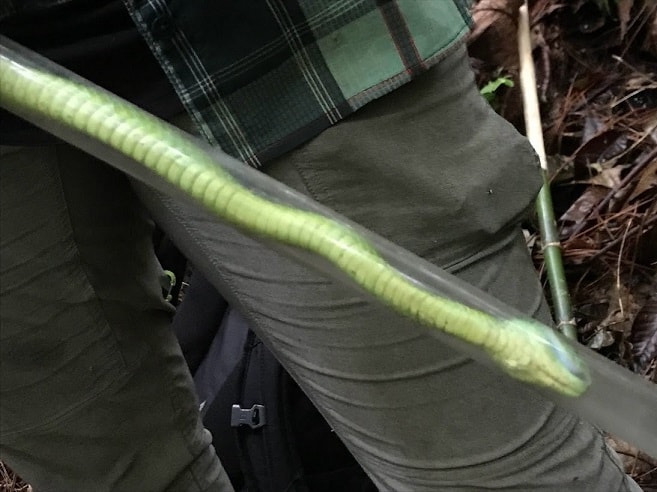
A venomous snake of western Honduras and eastern Guatemala. March’s palm pitviper has only a small empire, but it knows that empire inside out. March’s palm pitviper is difficult to spot for two reasons: 1) their immense greenness, and 2) their immense climbing skills. This species is so secure on tree branches that it can ascend 20 metres, and possibly higher. If your eyes were actually on them, you still might not notice this snake if they were in the midst of disguising foliage.
Many explorers have walked below Bothriechis marchi and not noticed its presence. This Guatemalan species measures 80cm, and is neither too thick nor too thin. They’re very poorly researched, with no diet nor venom data. They’re believed to climb far higher as adults than newborns.
This 5 minute video above shows your best chance: if March’s palm pitvipers must leave their shelter to cross a river. The video shows how slow and deliberate this snake is, rather than an easily visible whipsnake. Bothriechis marchi’s colours are a double-edged sword, standing out in the open, but vanishing in matching green vegetation.
| 9 | Rock rattlesnake |
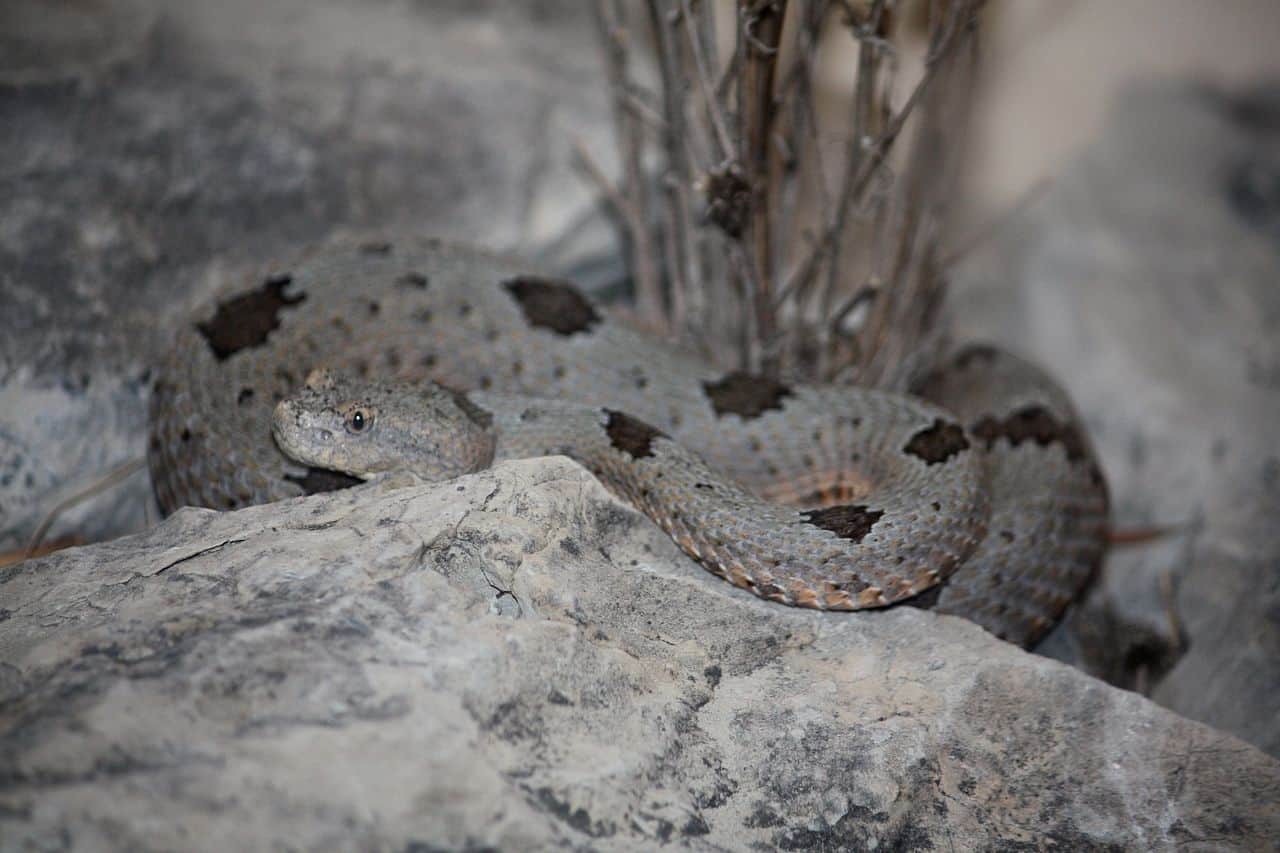
One of the hardest US rattlesnakes to spot. Tiger rattlesnakes are abundant by desert highways, while western diamondbacks are so large that nobody could miss them. Meanwhile, rock rattlesnakes combine grey colours with rugged locations that could easily slice your knee open. Rock rattlesnakes (Crotalus lepidus) live in craggy desert hills far from humanity, never appearing near sprinkler-fed resort towns. They live in Arizona and Texas, particularly on rocky slopes near remote hiking trails, in classic western country.
Rock rattlesnakes use rock crevices for shelter during the long days of oppressive sunlight. They also hibernate in these rock cracks. The rock rattlesnake’s patterns consist of light grey contrasting against darker grey, similarly to Lataste’s viper. They’re slow-moving and only a moderate length rattlesnake at a maximum of 80cm. The end result is a venomous snake which is very difficult to spot. Like horned adders, they even change colour based on soil type; those in volcanic southwest Texas are much darker.
Luck is important for spotting a rock rattlesnake. At intermittent periods, they leave their rock fields and drop to the parched arroyos below to hunt lizards. Even here, they tend to stay within shrubby shelters. John Wayne’s ghost has a better chance of seeing a rock rattlesnake than most hikers.
| 10 | Turtle-headed sea snake |
A mildly venomous snake which preys exclusively on eggs. Turtle-headed sea snakes (Emydocephalus annulatus) measure 80cm and live off the east coast of Australia. Their hunting strategy is constant prowling, scanning every corner of their coral reefs for stashed eggs, before slurping up the delicious goo.
Whether it’s Great Barrier Reef or Ashmore Reef, their world capitals are common knowledge. But when you descend with your scuba diving equipment and oxygen, things become more complex than the picture perfect image on google suggests. Turtle-headed sea snakes are a vivid snake with rapidly alternating black and white. They don’t camouflage in the slightest, but coral reefs are such an explosion of mesmerising colour and exotic creatures that they can be impossible to make out.
With eels, gobies and alien seaweeds everywhere, turtle-headed sea snakes can easily blend with the crowd if they so wish. That’s not mentioning the nooks and crannies they can disappear into, or the many trenches. Turtle-headed sea snakes are non-aggressive, and if you did find one, they’d probably swim right past you.
